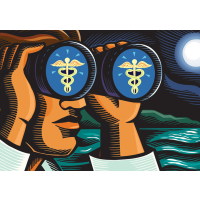Percentage of Insured Americans and Access to Doctors Worse than Nearly All Other Industrialized Nations
 (graphic: Imagezoo/Getty Images)
(graphic: Imagezoo/Getty Images)
By Aaron E. Carroll, New York Times
Many people are still unhappy with the Affordable Care Act.
The main intent of the law was to expand the safety net (Medicaid), regulate the non-employer-based private insurance market (the insurance exchanges) and help people buy that insurance (subsidies) in order to reduce the number of Americans who are uninsured.
On those metrics, it appears to be succeeding.
First and foremost, Obamacare was about improving access to health care. While it did improve access to insurance, in many, many other ways the United States is falling short. Things are likely to get worse before they get better.
Even with Obamacare, the United States still ranks poorly among comparable countries in insurance coverage. While the rate of insured in 2016 is the best it has ever been in the United States, a greater percentage of the U.S. population is uninsured than that of pretty much any other industrialized nation in the world.
Access is about more than insurance, though. Every few years, the Commonwealth Fund conducts an international survey of patients. The last time the fund fielded the survey was in 2013, and it sampled patients in 11 countries, all of them on the high end of the worldwide socioeconomic spectrum.
When asked if patients could get a same-day or next-day appointment with their provider when they were sick or needed care, 52 percent of Americans said no. This placed the United States next to last among these countries. Only Canada (59 percent) was worse.
Yes, we beat Canada. There’s a reason that politicians always seem to reach into that bucket when they want to provide evidence of U.S. health care exceptionalism. But comparing ourselves with only one country is cherry-picking. Many other countries outperform us.
When asked whether it was “somewhat” or “very easy” to get care after regular working hours, the United States placed eighth, beating France, Canada (again) and Sweden. Because of this, at least in part, Americans are more likely to use the emergency room for care. In this metric, the United States beat only Canada, with 39 percent of adults using the emergency room in the past two years.
Primary care physicians feel this pinch as well. When the Commonwealth Fund surveyed them in 10 countries, doctors in the United States ranked ninth (ahead of Canada) in being “well prepared” to manage the care of patients with complex needs. They ranked last in whether staff made home visits. They also ranked last, by far, in whether practices had arrangements so that patients could see a doctor or nurse after hours without going to the emergency department.
Why is this? One of the reasons is manpower. The United States, for all its spending, has fewer general practitioners per population than any of these other countries. In 2013, America had half as many primary care physicians per 1,000 people as the next-closest country (Sweden) and one-fifth the number in France or Germany.
There’s an element of supply and demand here. When you have too few primary care physicians, it won’t be as easy for patients to see them. When you give more people insurance, this problem will only get worse, when many new patients try to access the health care system.
None of this should be taken as an argument against reducing the number of uninsured. When we keep one group, a relatively poorer one, out of the system in order to improve everyone else’s access, we’re rationing — just by cost. Everyone in the United States seems to loathe rationing, so no one wants to admit that’s what’s going on.
The biggest access problem in the United States is the expense of obtaining care. More than one third of Americans said they did not fill a prescription they were given, did not visit the doctor they should have or did not get the tests that were ordered because of the cost.
Access was a problem before. Access is a problem now. Americans can’t seem to have a discussion on how to make that better. Without that, it’s hard to see how things will improve.
To Learn More:
Most Americans over 40 expect Long-Term Health Care to be Unaffordable (by Alexandra Cancino, Associated Press)
Those on High-Deductible Health Plans Often Do Without Medical Care (by Noel Brinkerhoff and Steve Straehley, AllGov)
California’s Obamacare Networks Are Fourth Narrowest in the Nation (by Ken Broder, AllGov California)
Covered California Survey Finds Nearly Half of Blue Shield/Anthem MDs Are MIA (by Ken Broder, AllGov California)
- Top Stories
- Unusual News
- Where is the Money Going?
- Controversies
- U.S. and the World
- Appointments and Resignations
- Latest News
- Trump to Stop Deportations If…
- Trump Denounces World Series
- What If China Invaded the United States?
- Donald Trump Has a Mental Health Problem and It Has a Name
- Trump Goes on Renaming Frenzy






Comments